- Choosing the Right Cucumber Seedlings
- Preparing the Greenhouse for Planting
- Clean the Greenhouse
- Provide Adequate Ventilation
- Check and Adjust Temperature and Humidity
- Prepare the Soil
- Provide Support Structures
- Install Irrigation System
- Consider Pest Control Measures
- Creating the Ideal Growing Conditions
- 1. Temperature
- 2. Humidity
- 3. Light
- 4. Ventilation
- 5. Watering
- 6. Nutrients
- 7. Support
- Planting Cucumber Seedlings
- Providing Proper Watering and Drainage
- Maintaining Temperature and Humidity
- Temperature
- Humidity
- Ventilation
- Monitoring and Adjusting
- Fertilizing Cucumber Plants
- Choose the Right Fertilizer
- Apply Fertilizer before Planting
- Top-Dress with a Liquid Fertilizer
- Use Organic Fertilizers
- Don’t Over-Fertilize
- Monitor Plant Health
- Pest and Disease Control
- 1. Insect Pests
- 2. Fungal Diseases
- 3. Bacterial Diseases
- 4. Integrated Pest Management
- “Question-Answer”
- What is the optimal temperature for planting cucumber seedlings in a greenhouse?
- How often should cucumber seedlings be watered in a greenhouse?
- Can cucumber seedlings be planted directly in the ground instead of a greenhouse?
- What is the recommended spacing for planting cucumber seedlings in a greenhouse?
- How long does it take for cucumber seedlings to mature in a greenhouse?
- Are any special nutrients or fertilizers needed for planting cucumber seedlings in a greenhouse?
- “Video” How To Grow Cucumbers Part 2 – Replanting
Planting cucumber seedlings in a greenhouse can be a great way to ensure a successful harvest. Greenhouses provide a controlled environment with optimal conditions for the growth and development of plants. However, there are several important steps you need to follow to ensure the successful planting of cucumber seedlings.
Step 1: Choose the right seedlings
When selecting cucumber seedlings for planting in the greenhouse, it is important to choose healthy, disease-free plants. Look for seedlings with sturdy stems, vibrant green leaves, and a well-developed root system. Avoid seedlings with yellow or wilted leaves, as they may not be strong enough to thrive in the greenhouse environment.
Step 2: Prepare the greenhouse
Prior to planting cucumber seedlings, make sure the greenhouse is properly prepared. Clean and disinfect the greenhouse to remove any potential pathogens or diseases. Set up proper ventilation and ensure the greenhouse is well-lit with sufficient access to sunlight. Maintain the temperature and humidity levels within the optimal range for cucumber growth.
Step 3: Plant the seedlings
Plant the cucumber seedlings at the appropriate depth, typically about 1 inch deep. Space the seedlings 12 to 18 inches apart to allow for proper growth and airflow. Gently firm the soil around the seedlings and water them thoroughly. Avoid overwatering, as this can lead to root rot and other diseases.
Step 4: Provide support
Cucumber plants are vining plants that benefit from vertical support. Install trellises or stakes in the greenhouse to help the plants grow upwards. This not only saves space but also allows for proper air circulation and prevents the fruits from rotting on the ground. Train the cucumber vines to climb the support structure as they grow.
Step 5: Monitor and care for the seedlings
Regularly monitor the greenhouse environment and make adjustments as necessary. Ensure the temperature is maintained around 70-75 degrees Fahrenheit during the day and 60-65 degrees Fahrenheit at night. Provide adequate water and fertilization, following the recommended guidelines for cucumber plants. Monitor for pests and diseases and take appropriate measures to control them.
By following these steps and maintaining optimal conditions, you can successfully plant cucumber seedlings in the greenhouse and enjoy a bountiful harvest. Remember to stay attentive throughout the growing season and provide the necessary care for your cucumber plants.
Choosing the Right Cucumber Seedlings
When it comes to choosing cucumber seedlings for your greenhouse, there are a few key factors to consider. This step is crucial as it lays the foundation for a successful cucumber crop. Here are some tips to help you select the right cucumber seedlings:
- Look for healthy seedlings: Opt for seedlings that appear strong and vigorous. They should have a vibrant green color and show no signs of wilting or yellowing. Avoid seedlings with damaged leaves or stems.
- Check for disease-free plants: Inspect the seedlings for any signs of common cucumber diseases such as powdery mildew or downy mildew. Look for spots, discoloration, or any unusual growth patterns on the leaves and stems.
- Consider the growth stage: It is important to choose seedlings that are at the right stage of growth for transplanting. Look for seedlings that have a few sets of true leaves and a well-developed root system. Avoid seedlings that are too small or too large.
- Choose the right cucumber variety: Different cucumber varieties have varying growth habits and preferences. Consider the specific requirements of the cucumber variety you want to grow in your greenhouse. This includes factors such as the ideal temperature range and the required support structure for vining varieties.
- Buy from a reputable source: Purchasing cucumber seedlings from a reliable and reputable source can greatly increase your chances of obtaining healthy, disease-free plants. Look for a trusted nursery or supplier with a good track record.
Remember, choosing the right cucumber seedlings is a critical step in establishing a successful cucumber crop in your greenhouse. Taking the time to select healthy, disease-free seedlings can contribute to higher yields and better overall plant performance.
Preparing the Greenhouse for Planting
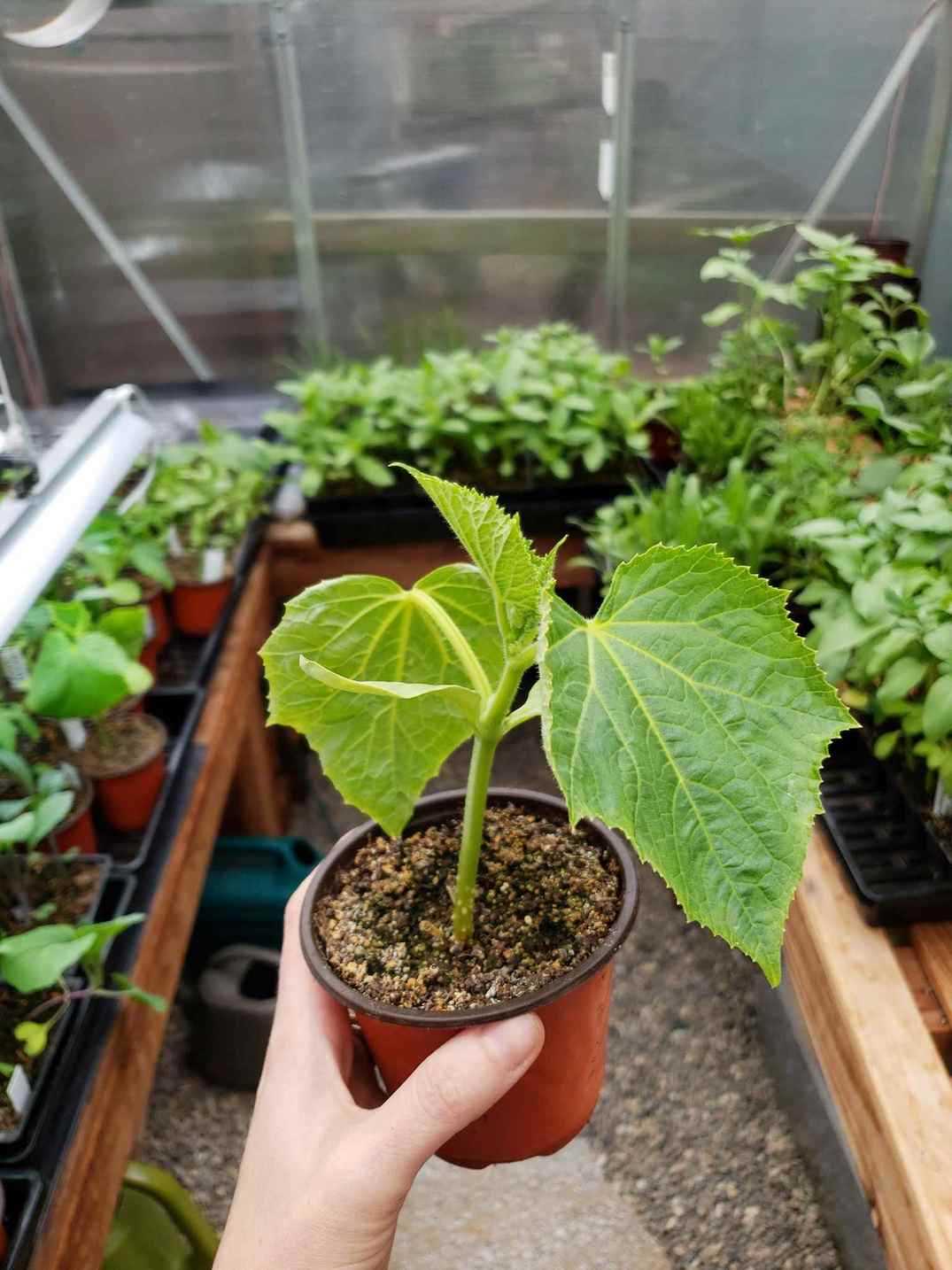
Before planting cucumber seedlings in the greenhouse, it is important to properly prepare the environment to ensure optimal growing conditions. By taking the following steps, you can create a suitable environment for the cucumber plants to thrive.
Clean the Greenhouse
Start by thoroughly cleaning the greenhouse to remove any debris or pests that may be present. Remove all old plant material and sanitize the surfaces with a mild bleach solution to reduce the risk of disease.
Provide Adequate Ventilation
Proper ventilation is crucial in a greenhouse to prevent heat buildup and excessive humidity. Install vents or fans to ensure good air circulation, which helps to regulate temperature and reduce the risk of fungal diseases.
Check and Adjust Temperature and Humidity
Monitor the temperature and humidity levels inside the greenhouse. Cucumber plants prefer a temperature range of 70-85°F (21-29°C) during the day and slightly cooler temperatures at night. Maintain humidity levels between 60-80% to promote healthy growth.
Prepare the Soil
Prepare the soil by removing any weeds and debris. Test the soil’s pH level and make necessary adjustments to ensure it falls within the optimal range of 6-6.8. Incorporate organic matter, such as compost or well-rotted manure, to improve the soil’s fertility and drainage.
Provide Support Structures
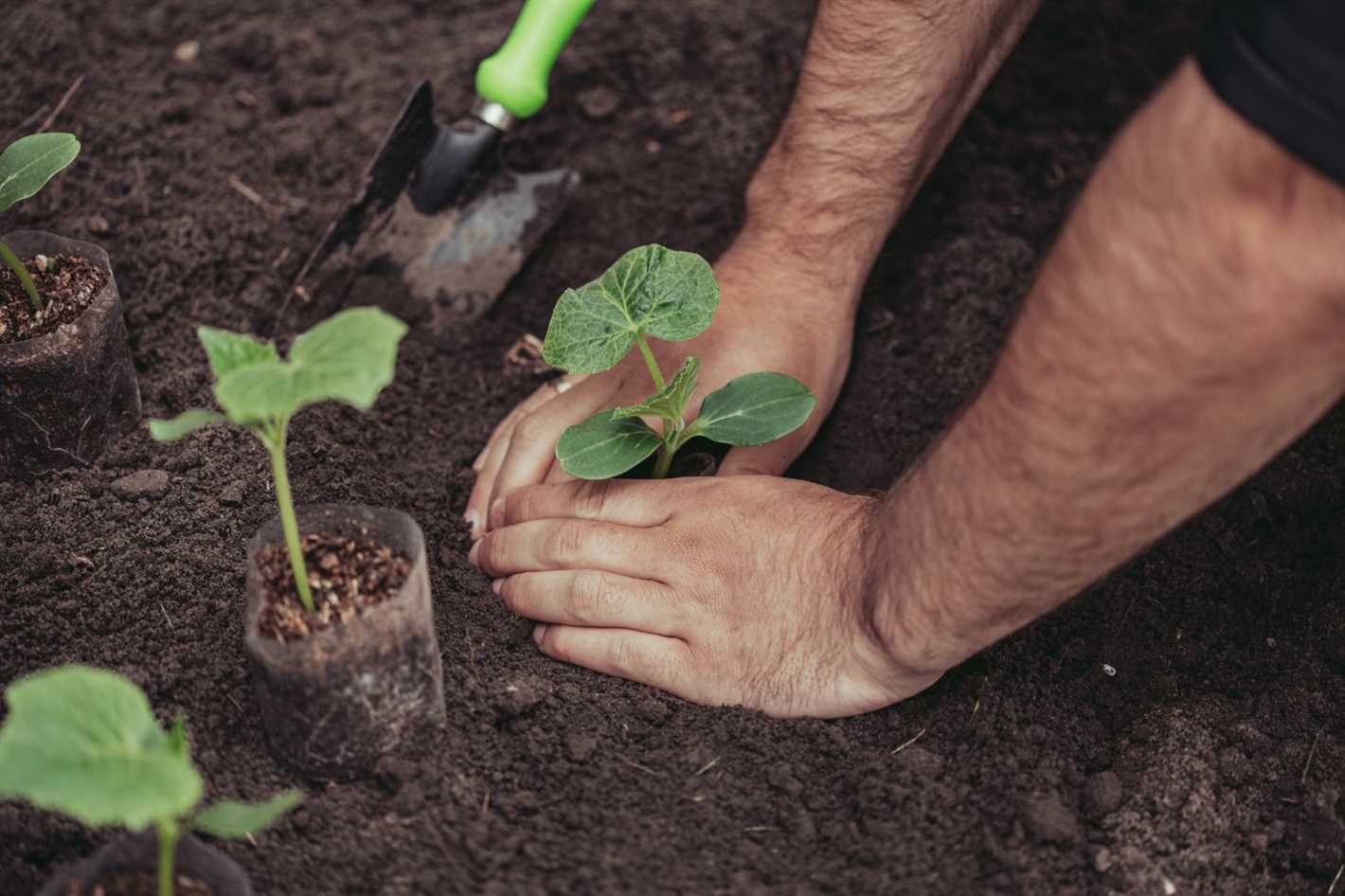
Cucumber plants are climbers and require support to grow vertically. Install trellises, stakes, or cages to support the plants and keep the fruits off the ground. This helps prevent diseases and improves air circulation around the plants.
Install Irrigation System
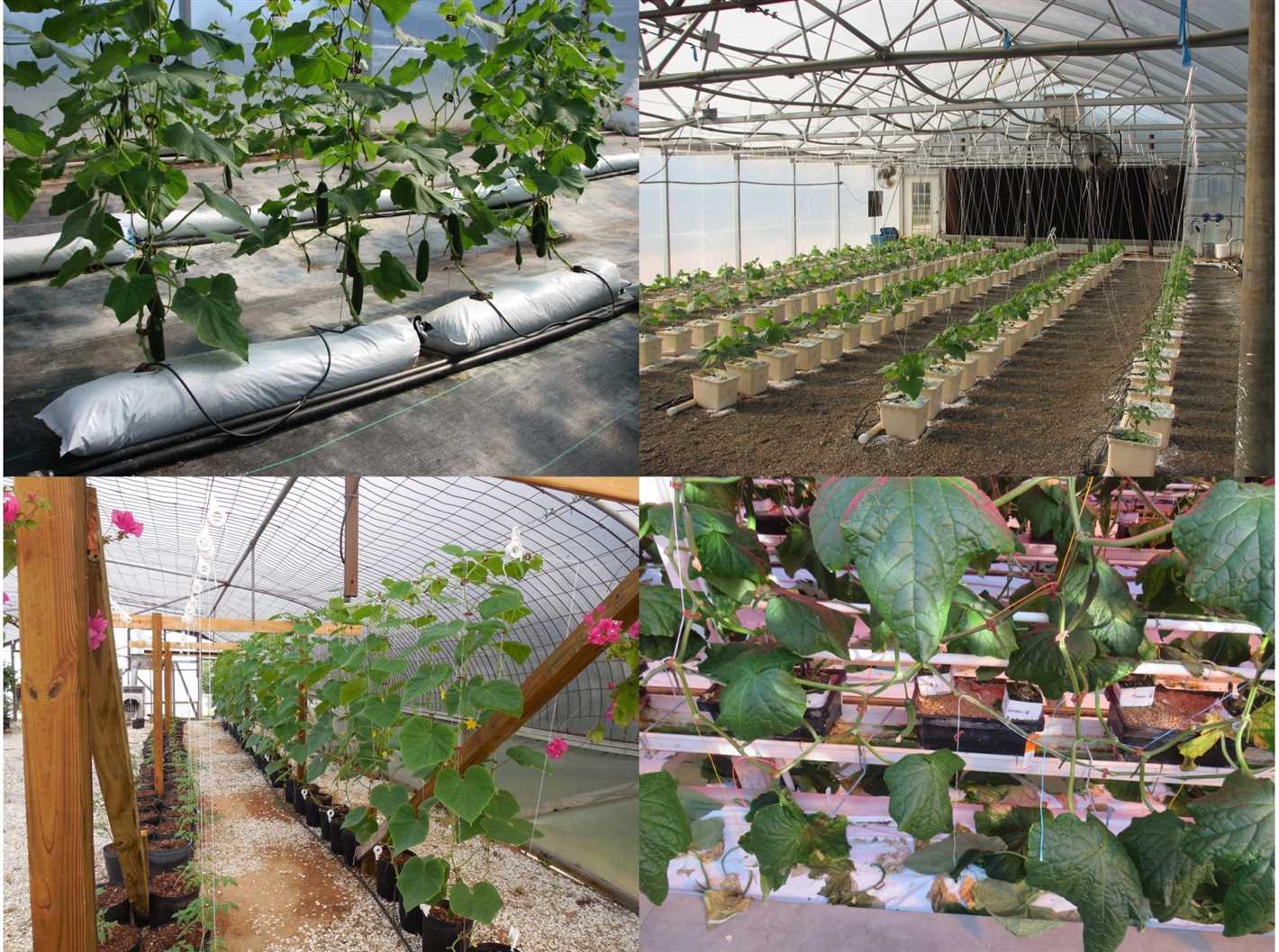
An efficient irrigation system is essential for proper watering of cucumber plants. Install drip irrigation or a soaker hose system to ensure consistent moisture without wetting the foliage. This reduces the risk of fungal diseases and water stress.
Consider Pest Control Measures
Take preventative measures to control pests in the greenhouse. Regularly inspect the plants for signs of pests and diseases and take appropriate action. Consider using organic pest control methods or introducing beneficial insects, such as ladybugs or predatory mites, to help control common greenhouse pests.
By following these steps to prepare your greenhouse, you can create a favorable environment for planting cucumber seedlings and ensure their successful growth and productivity.
Creating the Ideal Growing Conditions
Creating the ideal growing conditions for cucumber seedlings in the greenhouse is crucial for their successful development. By providing the right environment, you can ensure healthy growth and maximize your harvest. Here are some key steps to take:
1. Temperature
Maintaining the right temperature is essential for cucumber seedlings. The optimal temperature range for cucumber growth is between 75°F (24°C) and 85°F (29°C) during the day. At night, the temperature can be slightly cooler, between 65°F (18°C) and 70°F (21°C). Use a thermometer to monitor the temperature regularly and make adjustments if necessary.
2. Humidity
Cucumber seedlings thrive in high humidity levels. Aim for a humidity range of 60% to 70%. To increase humidity, you can use a humidifier or place trays of water near the seedlings. Regularly misting the plants with water can also help maintain humidity levels.
3. Light
Cucumbers require at least 8 hours of direct sunlight per day for optimal growth. If your greenhouse doesn’t receive enough natural light, consider using grow lights to supplement the lighting. Position the lights overhead and adjust the height to ensure uniform light distribution.
4. Ventilation
Proper ventilation is essential to prevent the buildup of excessive heat and humidity. Install vents or use fans to circulate air in the greenhouse. This helps regulate the temperature and prevents fungal diseases caused by stagnant air. Avoid drafts by ensuring windows and doors are properly sealed.
5. Watering
Consistent watering is critical for cucumber seedlings. Keep the soil evenly moist, but not waterlogged. Overwatering can lead to root rot, while underwatering can cause stunted growth. Water the seedlings at the base to prevent wetting the leaves, as this can promote fungal diseases.
6. Nutrients
Cucumber seedlings require a balanced supply of nutrients to grow properly. Use a well-draining soil mix enriched with organic matter. Fertilize the seedlings with a balanced fertilizer once they have developed their first true leaves. Follow the manufacturer’s instructions for application rates.
7. Support
Cucumber vines can grow quite long and require support for proper growth. Install trellises or stakes in the greenhouse before planting the seedlings. This will provide support for the vines as they grow, prevent them from trailing on the ground, and promote better air circulation.
By creating the ideal growing conditions for cucumber seedlings in your greenhouse, you can ensure healthy development and a bountiful harvest. Regular monitoring and adjustments to temperature, humidity, light, ventilation, watering, nutrients, and support will ensure the best results for your cucumber plants.
Planting Cucumber Seedlings
Planting cucumber seedlings in a greenhouse requires proper planning and attention to detail to ensure successful growth and a bountiful harvest. Here is a step-by-step guide on how to plant cucumber seedlings in a greenhouse:
- Prepare the soil: Cucumbers thrive in well-drained soil rich in organic matter. Before planting, ensure the soil is loosened and free from any weeds or debris. Adding compost or organic matter will improve the soil’s fertility and drainage.
- Start with healthy seedlings: Choose healthy cucumber seedlings with strong stems and leaves. Avoid seedlings with any signs of disease or pest damage.
- Water the seedlings: Before planting, water the seedlings thoroughly to hydrate the roots and make it easier to remove them from their containers.
- Dig holes: Dig holes in the prepared soil that are deep enough to accommodate the root system of each cucumber seedling.
- Plant the seedlings: Gently remove each seedling from its container and place it in the prepared hole. Make sure the root system is spread out and covered with soil, leaving the stem and leaves above the surface.
- Space the seedlings: Depending on the cucumber variety, leave enough space between the seedlings to allow for proper growth and air circulation. This will help prevent overcrowding and reduce the risk of disease.
- Water the seedlings again: After planting, water the seedlings thoroughly to settle the soil and provide moisture to the roots. Avoid overwatering, as it can lead to root rot and other issues.
- Provide support: Cucumber plants benefit from trellises or stakes to support their vines as they grow. Install the support system at the time of planting to avoid disturbing the roots later on.
- Maintain optimal conditions: Cucumbers prefer warm temperatures between 70-85°F (21-29°C) and high humidity. Provide adequate ventilation and monitor the greenhouse environment to ensure optimal conditions for growth.
- Monitor and care for the plants: Regularly check the seedlings for signs of pests, diseases, or nutrient deficiencies. Water the plants as needed and remove any weeds that may compete for nutrients.
- Harvest the cucumbers: Once the cucumber plants start producing fruits, harvest them when they reach the desired size. Regular harvesting promotes continuous production and keeps the plants healthy.
By following these steps and providing the optimal growing conditions, you can successfully plant cucumber seedlings in a greenhouse and enjoy a bountiful harvest of delicious cucumbers.
Providing Proper Watering and Drainage
Adequate watering and proper drainage are crucial for the healthy growth of cucumber seedlings in a greenhouse. When providing water to your seedlings, it’s important to follow these steps:
- Establish a watering schedule: Consistency is key when it comes to watering cucumber seedlings. Determine a regular watering schedule, ideally watering them on the same day and time each week.
- Water deeply: When watering cucumber seedlings, it’s important to ensure that the water reaches the roots. Water deeply to encourage the roots to grow downwards, which will help establish a strong support system for the plants.
- Use a drip irrigation system: Installing a drip irrigation system can be an efficient way to provide water to your cucumber seedlings. This method allows for slow, consistent watering directly to the roots, minimizing evaporation and reducing the risk of overwatering.
- Monitor soil moisture: Regularly check the moisture level of the soil to avoid either overwatering or underwatering your cucumber seedlings. Insert your finger into the soil up to the second knuckle – if it feels dry, it’s time to water.
- Water in the morning: It’s best to water your cucumber seedlings in the morning, as this allows the leaves and soil surface to dry out before evening. Watering in the evening or at night can create a damp environment, increasing the risk of fungal diseases.
In addition to proper watering, providing adequate drainage is equally important for the health of your cucumber seedlings. Here are some tips for ensuring good drainage:
- Use well-draining soil: Start by using a high-quality potting mix that is specifically formulated for greenhouse plants. Avoid heavy clay soils, as they tend to retain water and can lead to root rot.
- Add drainage material: To improve drainage in your greenhouse containers, consider adding a layer of pebbles or broken pottery pieces at the bottom. This will help prevent water from pooling at the bottom and keep the soil from becoming waterlogged.
- Provide drainage holes: Ensure that your greenhouse containers have sufficient drainage holes at the bottom to allow excess water to escape. If necessary, drill additional holes to improve drainage.
- Elevate containers: If possible, place your greenhouse containers on top of a raised platform or use pot feet to elevate them slightly. This will promote better airflow and drainage, preventing water from accumulating around the roots.
By following these watering and drainage practices, you can create a healthy and optimal environment for your cucumber seedlings to thrive in the greenhouse.
Maintaining Temperature and Humidity
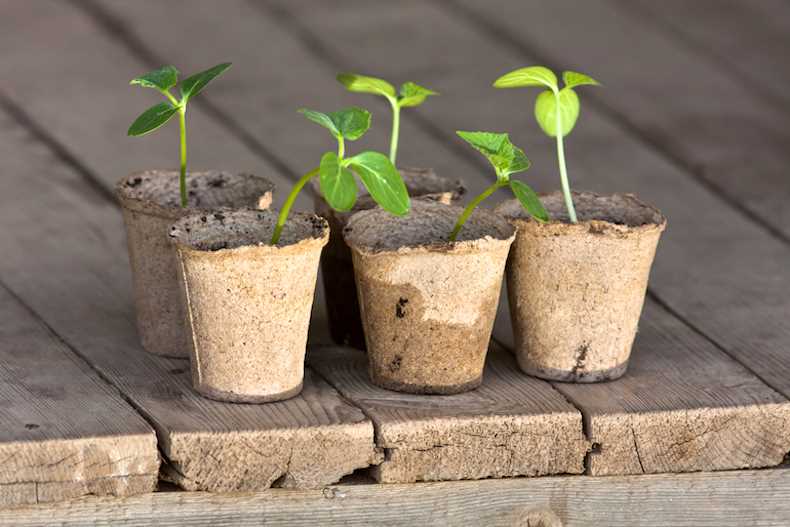
Proper temperature and humidity levels are essential for the successful growth of cucumber seedlings in a greenhouse. By maintaining optimal conditions, you can ensure that your seedlings have the best chance of thriving.
Temperature
Cucumber seedlings require a warm environment to grow successfully. The ideal temperature range for cucumber seedlings is between 70 to 85 degrees Fahrenheit (21 to 29 degrees Celsius). It is important to provide consistent heat to the seedlings during both the day and night.
Consider using a greenhouse heater or heating mats to maintain a stable temperature. Place a thermometer in the greenhouse to monitor the temperature regularly.
Humidity
Cucumber seedlings thrive in high humidity conditions. They require a relative humidity between 70% to 80% for optimal growth. Maintaining proper humidity levels can help prevent issues such as drying out or damping-off disease.
There are several ways to increase humidity in a greenhouse. One method is to use a humidifier specifically designed for greenhouse use. Another option is to place trays of water near the seedlings or mist them with water regularly. These methods help to increase the moisture in the greenhouse air.
Ventilation
In addition to maintaining the correct temperature and humidity, proper ventilation is crucial for cucumber seedling growth. Good air circulation helps prevent the build-up of excess moisture and prevents the spread of diseases.
Ensure that the greenhouse has enough ventilation options, such as windows, vents, or fans. Opening windows and vents during the day when temperatures are higher can help regulate the greenhouse environment and allow for fresh air circulation.
Monitoring and Adjusting
It is important to regularly monitor the temperature and humidity levels in the greenhouse and make adjustments as needed. Changes in outdoor weather or fluctuations in the greenhouse environment can impact the conditions inside.
Use a hygrometer and thermometer to keep track of the temperature and humidity levels. If the conditions are not within the optimal range, adjust the heating, cooling, or humidifying systems accordingly to ensure the best environment for your cucumber seedlings.
Fertilizing Cucumber Plants
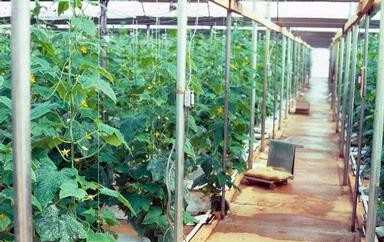
Cucumber plants require regular fertilization to ensure healthy growth and abundant fruiting. Here are some tips for fertilizing cucumber plants in the greenhouse:
Choose the Right Fertilizer
When selecting a fertilizer for cucumber plants, it is important to choose one that is high in nitrogen, phosphorus, and potassium, as these are the key nutrients required for healthy growth. Look for a balanced fertilizer with an NPK (nitrogen, phosphorus, potassium) ratio of around 10-10-10 or similar.
Apply Fertilizer before Planting
Before planting cucumber seedlings in the greenhouse, it is recommended to incorporate a slow-release granular fertilizer into the soil. This will provide a steady supply of nutrients throughout the growing season and help establish strong, healthy plants.
Top-Dress with a Liquid Fertilizer
Once the cucumber plants are established, it is beneficial to top-dress them with a liquid fertilizer every 2-3 weeks. A liquid fertilizer can be easily absorbed by the plants and provide a quick boost of nutrients. Dilute the liquid fertilizer according to the manufacturer’s instructions and apply it directly to the soil near the base of the plants.
Use Organic Fertilizers
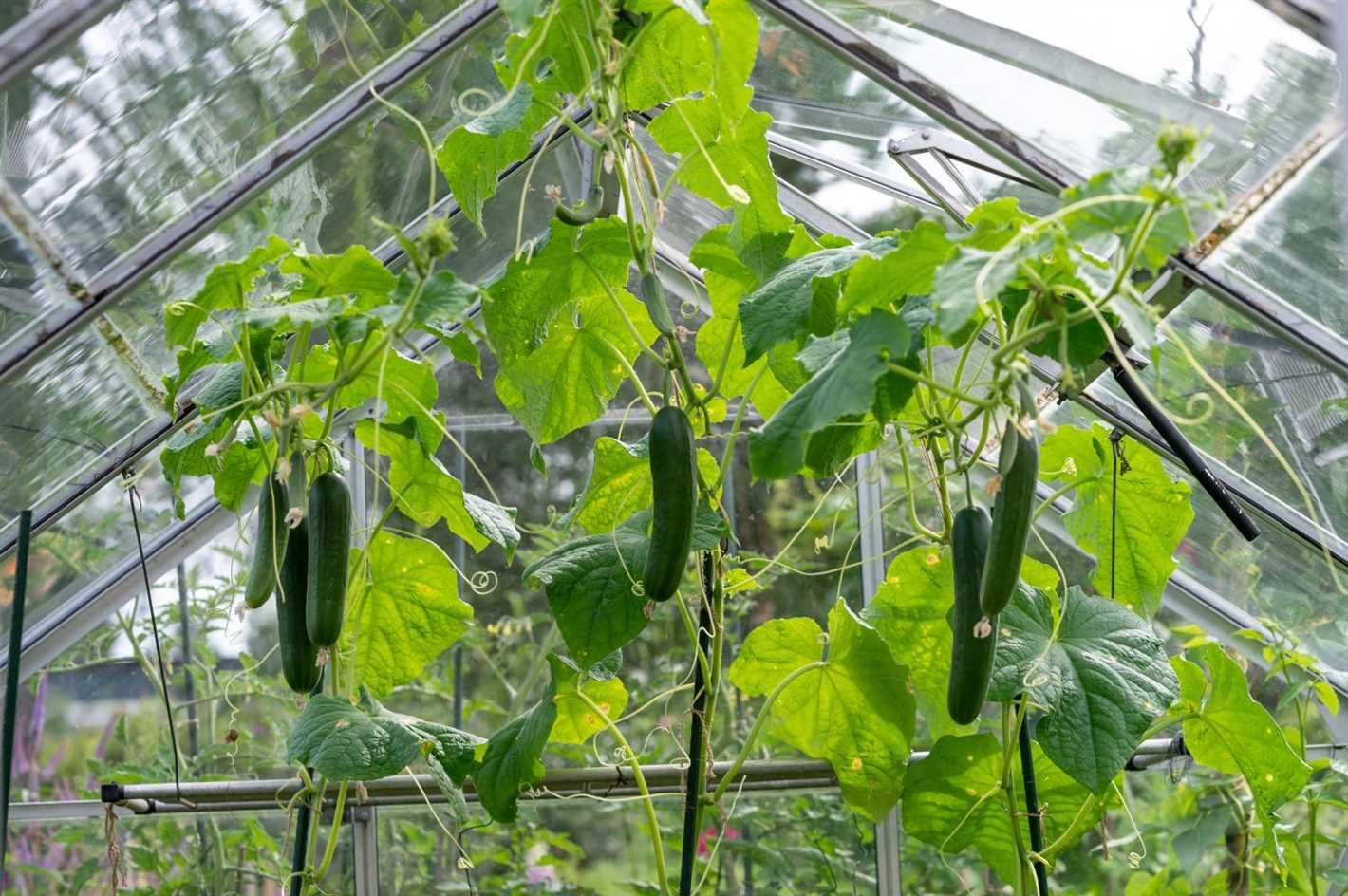
If you prefer to use organic fertilizers, there are plenty of options available. Compost, well-rotted manure, and worm castings are all excellent choices for providing nutrients to cucumber plants. These organic fertilizers not only supply nutrients but also improve soil structure and fertility over time.
Don’t Over-Fertilize
While it is important to provide cucumber plants with the necessary nutrients, it is crucial not to over-fertilize. Excessive amounts of fertilizer can lead to salt buildup in the soil, which can harm the plants and reduce productivity. Always follow the recommended dosage and application instructions provided by the fertilizer manufacturer.
Monitor Plant Health
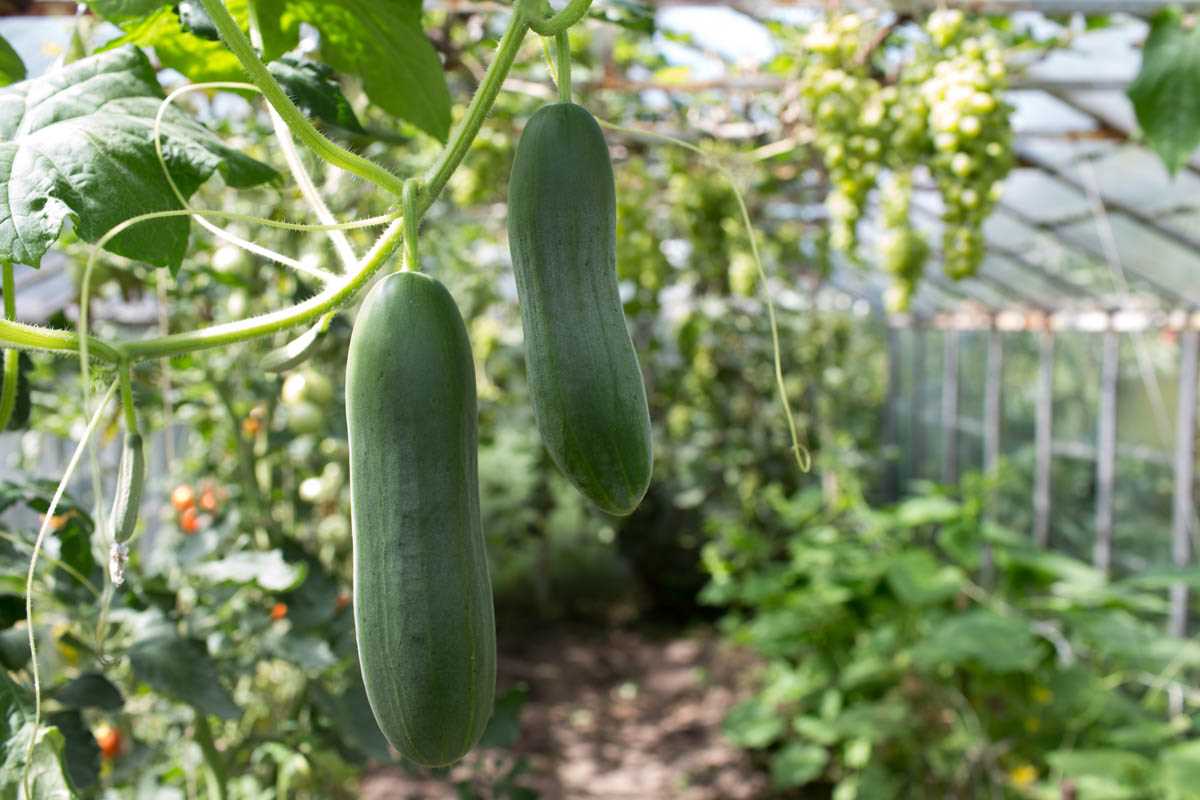
Regularly monitor the health and growth of your cucumber plants. Signs of nutrient deficiency, such as yellowing leaves or stunted growth, may indicate the need for additional fertilization. Adjust your fertilization routine accordingly to ensure optimal plant health and productivity.
By following these fertilization tips, you can support the growth and productivity of your cucumber plants in the greenhouse. Remember to provide the right nutrients at the right time to ensure healthy and abundant harvests.
Pest and Disease Control
Proper pest and disease control is essential for ensuring the healthy growth of cucumber seedlings in the greenhouse. Here are some tips to help you prevent and manage common pests and diseases:
1. Insect Pests
- Aphids: Inspect your cucumber seedlings regularly for aphids, which are small green or black insects that suck sap from the leaves. Use insecticidal soap or neem oil to control aphids.
- Spider mites: Spider mites are tiny pests that infest cucumber plants and cause yellowing and webbing. Use a miticide or insecticidal soap to control spider mites.
- Thrips: Thrips are small insects that can damage cucumber seedlings by feeding on the leaves. Use sticky traps or insecticidal soap to control thrips.
2. Fungal Diseases
- Damping-off: Damping-off is a common fungal disease that affects young cucumber seedlings. To prevent damping-off, ensure proper air circulation, avoid overwatering, and use sterilized soil or growing medium.
- Powdery mildew: Powdery mildew is a fungal disease that causes a white powdery coating on the leaves. To control powdery mildew, remove and destroy infected leaves, improve air circulation, and use fungicides if necessary.
- Downy mildew: Downy mildew is another common fungal disease that affects cucumber seedlings. It causes yellowing and browning of leaves. To prevent downy mildew, avoid overhead watering and use copper-based fungicides.
3. Bacterial Diseases
- Bacterial leaf spot: Bacterial leaf spot is a bacterial disease characterized by dark spots on the leaves. To control bacterial leaf spot, remove and destroy infected leaves, avoid overhead watering, and use copper-based fungicides.
- Bacterial wilt: Bacterial wilt is a serious bacterial disease that affects cucumber seedlings. Infected plants show wilting and yellowing of leaves. To prevent bacterial wilt, use disease-resistant cucumber varieties and practice crop rotation.
4. Integrated Pest Management
Implementing integrated pest management (IPM) techniques can help prevent and control pests and diseases in your cucumber greenhouse. Some IPM strategies include:
- Regularly monitoring and scouting for pests and diseases.
- Using natural enemies like ladybugs and parasitic wasps to control insect pests.
- Practicing good greenhouse sanitation to reduce disease risk.
- Using physical barriers like row covers to exclude pests.
- Using resistant cucumber varieties whenever possible.
By following these tips for pest and disease control, you can ensure the health and productivity of your cucumber seedlings in the greenhouse.
“Question-Answer”
What is the optimal temperature for planting cucumber seedlings in a greenhouse?
The optimal temperature for planting cucumber seedlings in a greenhouse is between 70-85 degrees Fahrenheit (21-29 degrees Celsius).
How often should cucumber seedlings be watered in a greenhouse?
Cucumber seedlings in a greenhouse should be watered regularly to keep the soil moist, but not waterlogged. This typically means watering them every 2-3 days.
Can cucumber seedlings be planted directly in the ground instead of a greenhouse?
Yes, cucumber seedlings can be planted directly in the ground instead of a greenhouse. However, using a greenhouse provides a controlled environment that is ideal for their growth and can help protect them from extreme weather conditions.
What is the recommended spacing for planting cucumber seedlings in a greenhouse?
The recommended spacing for planting cucumber seedlings in a greenhouse is usually between 12-24 inches (30-60 cm) apart, depending on the specific variety. This allows enough room for the plants to grow and spread without overcrowding each other.
How long does it take for cucumber seedlings to mature in a greenhouse?
The time it takes for cucumber seedlings to mature in a greenhouse can vary depending on the specific variety, growing conditions, and care given to the plants. On average, it takes about 55-70 days for cucumber seedlings to mature and start producing fruit.
Are any special nutrients or fertilizers needed for planting cucumber seedlings in a greenhouse?
Yes, cucumber seedlings planted in a greenhouse may benefit from the use of a balanced fertilizer that is high in nitrogen. This can help promote healthy plant growth and fruit production. It is important to follow the manufacturer’s instructions for proper application and dosage.







